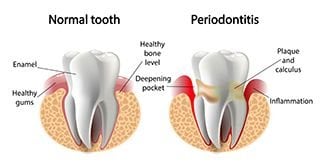Periodontics in Woodbridge, VA
Periodontal (gum) disease, also known as periodontitis, is a bacterial infection that inflames the soft tissue around your teeth and becomes more severe if left untreated. Over time, gum disease will erode the bone that supports your teeth, leading to mobility and tooth loss. Gum disease is quite common, though very preventable, because it is usually a result of poor oral hygiene habits.

What are the Stages of Gum Disease?
Gingivitis
The first stage of gum disease presents itself with red, swollen, and bleeding gums. It is the only stage of gum disease that can be reversed, as there hasn’t been any damage done to bone yet. Brushing and flossing your teeth at least twice a day and visiting your Woodbridge, VA dentist at Occoquan Smiles for checkups and professional cleanings every six months is an infallible way to prevent gingivitis.
Mild Periodontitis
If gingivitis is left untreated, it will progress into mild periodontitis. At this stage, your gums will begin to pull away from your teeth and some bone loss will occur. Periodontal pockets will also develop, where it’s easier for plaque, tartar, and bacteria to become trapped. A toothbrush and floss will not be able to reach inside these pockets. Though reversing this stage is no longer possible, it can still be maintained by a periodontist, like Dr. Ramy Habib here at our practice, who will offer proper oral hygiene techniques and may even recommend deep cleaning procedures.
Moderate Periodontitis
As periodontitis progresses, bacteria will continue to damage the ligaments, joints, and soft tissues surrounding your tooth, root, and socket. At this stage, you will experience sore and tender gums and what damage has been done is now permanent.
Severe Periodontitis
The most severe stage of gum disease presents with receding and bleeding gums, halitosis, pus-filled abscesses, gapping, and changes in bite. If your periodontitis has progressed this far, you will experience loose teeth as the infection keeps eating away at bone. Some teeth may have even already fallen out.
What are the Causes of Gum Disease?
While the main cause of gum disease is poor oral hygiene, other risk factors exist, such as:
- Smoking: Weakens your body’s ability to fight infection, making it more difficult for gum tissue to repair itself.
- Autoimmune diseases: People who suffer from autoimmune diseases, like diabetes, cancer, and HIV, have a weakened immune system and so their bodies have a harder time fighting off infections.
- Genetics: If your family is more prone to dental disease, you can ultimately face dental disease as well.
- Hormonal changes: The risk for gum disease increases in women when hormones are affected by pregnancy, birth control pills, puberty, menopause, or menstruation.
- Chronic inflammation: Health conditions that cause inflammation in your body, such as arthritis, COVID-19, or cardiovascular disease, are linked to gum disease.
- Certain medications: Medications that reduce your production of saliva or cause abnormal growth of gum tissue, such as Dilantin, Procardia, and Adalat, can cause gum disease.
What are Common Gum Disease Treatments?
Treatment is always going to be dependent on the stage of gum disease. There are many options available, both nonsurgical and surgical.
Nonsurgical Treatments
Antibiotics
Oral antibiotics, either in pill or topical form, may be enough to fight off infection.
Scaling and root planing
Similar to a routine dental cleaning, SRP cleans much deeper. Local anesthesia will need to be used to numb your gums while your dental hygienist cleans away bacteria underneath your gum line and smooths the tooth roots to prevent further plaque and bacteria from accumulating beneath your gum line.
Surgical Treatments
Flap Surgery
Your periodontist will make an incision along your gum line, temporarily shifting the gum tissues away from your teeth. With the tooth roots more easily seen, your periodontist is able to clean them more thoroughly. If bone loss has occurred, your periodontist may re-contour your bone ridge to make it easier for your daily oral hygiene routine.
Dental Bone Grafts
If a significant amount of bone loss has occurred, bone-grafting material will be placed in areas where there is a lack of bone tissue. Dental bone grafts serve as a “scaffolding” to encourage new bone growth.
Gum Grafts
Gum disease causes gum recession, so a gum graft might be necessary to restore lost tissue around your teeth. Tissue is obtained from the roof of your mouth or a tissue bank and is sutured into the areas lacking gum tissue.
Guided Tissue Regeneration
A biocompatible membrane will be placed between your existing bone and tooth, keeping unwanted tissue from growing in the area and allowing bone to grow instead.
Platelet-Rich Plasma (PRP)
This procedure helps regenerate bone or gum tissue. Platelet-rich plasma is taken from a sample of your blood, is then placed in a centrifuge to separate red and white blood cells, and finally the plasma is placed in areas lacking bone or tissue to encourage growth.
